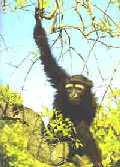Also known as Hoolock Gibbon and Whole-armed Gibbon, it belongs to the Pongidae family of Primates order, with the Latin scientific name of Hylobates hoolock, and English name of Hoolock Gibbon, or White-browed Gibbon.
 The length of its body is 46 to 68 centimeters, slightly larger than White-cheeked Gibbon and White-handed Gibbon. It is tall and thin, tailless and about 5.5 kilograms in weight. The size of male and female is similar, with male in black and brown while female in light yellow brown. The most obvious features are: two white eyebrows, hair on the vertices growing backwards, looking like the longevous gibbon. Baby gibbon is offwhite, which turns darker after several months.
The length of its body is 46 to 68 centimeters, slightly larger than White-cheeked Gibbon and White-handed Gibbon. It is tall and thin, tailless and about 5.5 kilograms in weight. The size of male and female is similar, with male in black and brown while female in light yellow brown. The most obvious features are: two white eyebrows, hair on the vertices growing backwards, looking like the longevous gibbon. Baby gibbon is offwhite, which turns darker after several months.
It inhabits in tropical virgin forests, living on the trees almost all the year round. It moves forward by hanging itself on tree branches with its two long arms and hook-shaped long hands, and swinging forward like playing on a swing. Its movement is quick and accurate. Occasionally, it walks on the ground; while walking, its body is in half erection, sometimes two arms bent at both sides of the body and sometimes lifted above the calvaria, like a pendulum. It usually lives in groups of 3 to 5, like a family. Its hue is very loud, which can be heard from several miles afar. It never builds nests, but sleeps and rests by sitting on the trees. As an omnivorous animal, it eats tree leaves, fruits, insects, birds and bird eggs. Baby gibbon matures at the age of 8 to 9, mostly oestrous in rainy seasons. Its gestation period lasts 7 to 7.5 months, giving birth to babies from November to March of the following year.
White-browed Gibbon is distributed in Yunnan Province and Tibet Autonomous Region of China. It is now on the verge of extinction, with a remaining number of about 200 heads. In Gongshan Mountain of Gaoli where white-browed gibbons inhabit, a natural protection area has been established by the State.
It has been listed in Appendix I ofInternational Trade Convention on Endangered Wild Plant and Animal Species.
